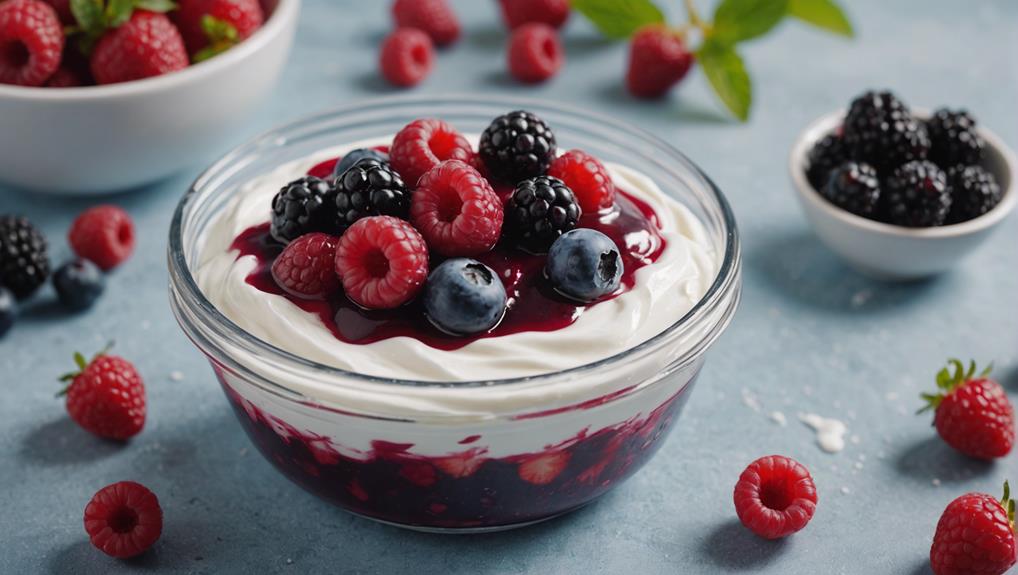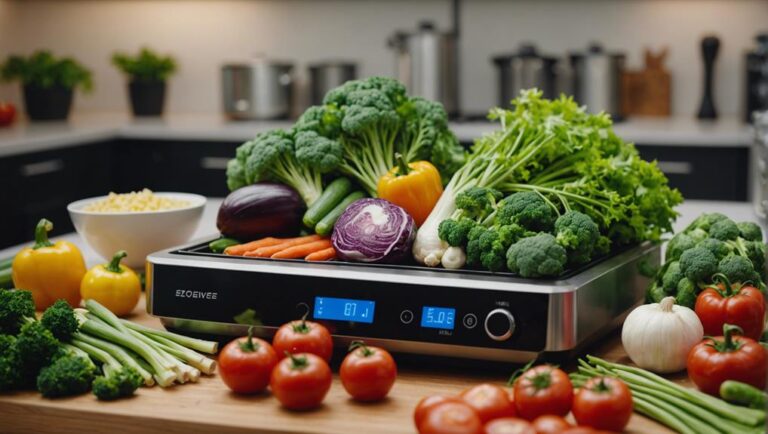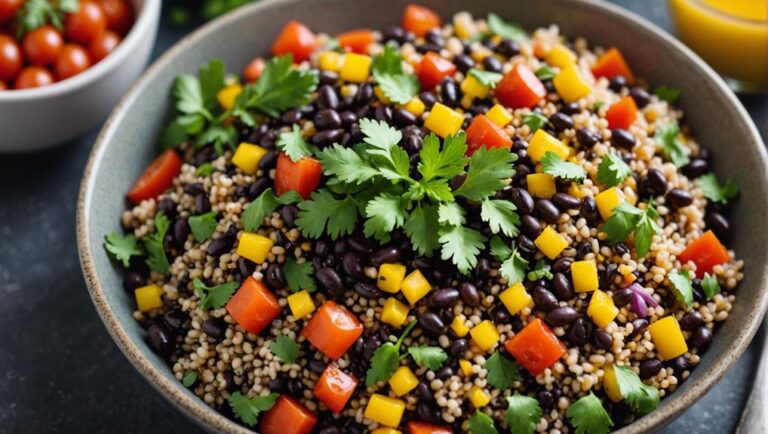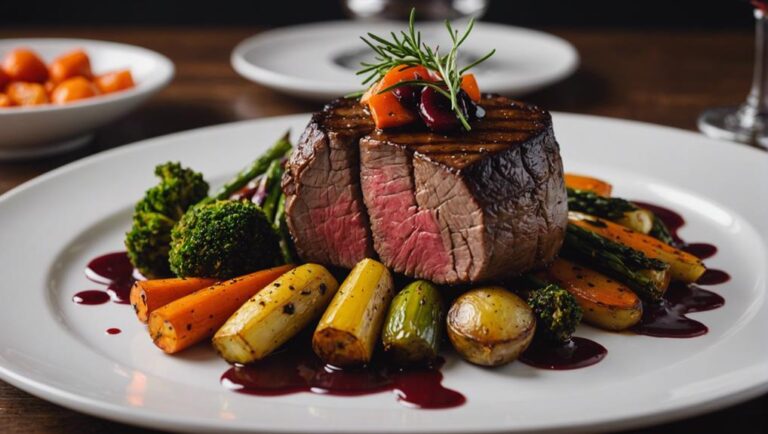Sous Vide Berry Compote With Greek Yogurt
Achieve berry compote brilliance with Greek yogurt using sous vide. Elevate the blend through precision cooking for peak flavors.
What You Will Learn Here
- Sous vide method enhances berry flavors for compote
- Greek yogurt pairs well with sous vide berry compote
- Experiment with various berry combinations for unique flavors
- Consistent results ensured with precise sous vide temperature control
- Convenient sous vide cooking for easy and delicious berry compote
Origin of Yogurt Making
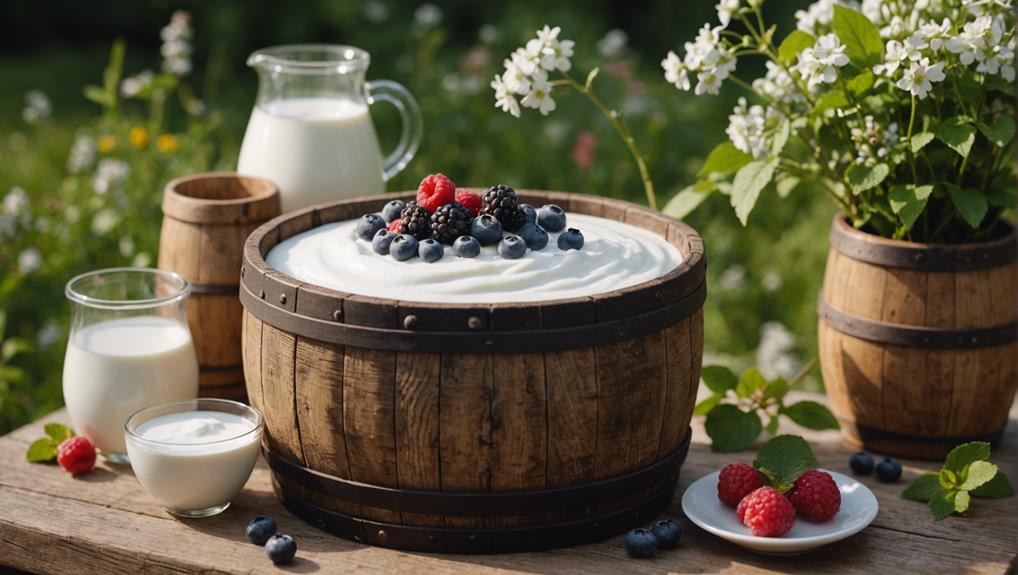
The origin of yogurt making can be traced back to ancient civilizations, such as Mesopotamia and India, where fermenting milk with live cultures was a common practice.
This historical process laid the foundation for the diverse range of yogurt varieties we enjoy today, including Greek yogurt.
Over time, yogurt-making techniques have advanced, incorporating modern methods like sous vide to guarantee consistent quality and flavor.
Yogurt History Overview
Originating over 4,500 years ago in ancient Mesopotamia, yogurt making is a time-honored practice that involves fermenting milk with live bacteria cultures. The word 'yogurt,' derived from Turkish, signifies the curdling or coagulation process during fermentation.
Greek yogurt, known for its thick and creamy texture, is a type of yogurt strained to remove whey, giving it a richer consistency. The origins of Greek yogurt can be traced back to ancient Greece, where it was commonly consumed for its nutritional benefits. Today, Greek yogurt remains a popular choice due to its higher protein content and versatility in various dishes.
The evolution of yogurt making techniques, from ancient civilizations to modern production methods, has contributed to its widespread consumption and culinary applications.
Cultural Significance Exploration
Exploring the cultural significance of yogurt making reveals a rich history of fermentation practices intertwined with culinary traditions. Yogurt, dating back to around 5000 BC in ancient Mesopotamia, holds a special place in the history of food preservation and probiotic-rich diets.
The word 'yogurt' itself originates from Turkish, meaning 'to thicken' or 'to curdle,' showcasing the process involved in its creation. Traditional yogurt making involves fermenting milk with live bacterial cultures like Lactobacillus bulgaricus and Streptococcus thermophilus, contributing to its tangy flavor and health benefits.
This ancient practice has evolved over time, giving rise to various regional variations like Greek yogurt, known for its thick and creamy texture achieved through straining. Yogurt's global popularity underscores its cultural significance, with diverse flavors and forms enjoyed worldwide.
Evolution of Yogurt-Making
Having roots dating back over 4,000 years, yogurt-making has undergone significant evolution from its ancient origins in Mesopotamia and the Middle East.
Homemade yogurt was traditionally crafted by fermenting milk to achieve a tangy, creamy consistency. Early methods involved utilizing materials like animal skins or clay pots to create the ideal incubation conditions for the yogurt cultures to thrive.
As yogurt-making spread to Europe and beyond, different regions adapted the process to suit local tastes and traditions. In modern times, innovations such as sous vide have transformed homemade yogurt production, offering a precise and controlled environment for achieving consistent results.
This evolution showcases how a simple yet ancient practice has evolved over millennia into a diverse and widespread culinary art form.
Yogurt-Making Essential Components
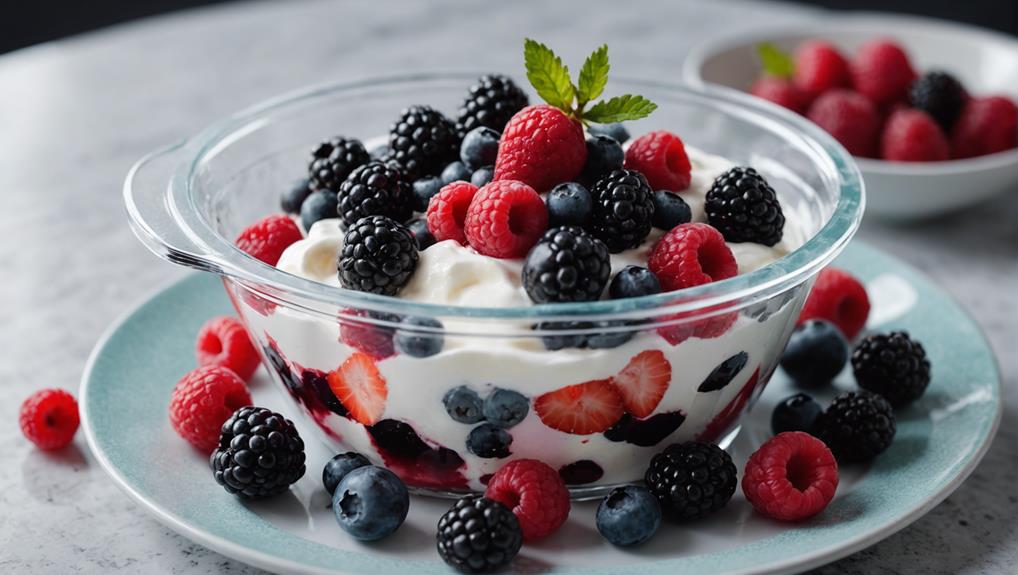
To guarantee successful yogurt-making using the sous vide method, precise temperature control and the use of live cultures are essential components. When preparing yogurt at home, the following factors play an important role:
- Live Cultures: Introducing live cultures into the milk is crucial for the fermentation process, which converts the milk sugars into lactic acid, giving yogurt its characteristic tangy taste.
- Temperature Control: Maintaining specific temperature ranges is key. Heating the milk to 180°F helps denature proteins for a thicker consistency, while cooling it to 109°F provides an ideal environment for the live cultures to thrive.
- Consistent Incubation: Utilizing a sous vide device ensures a steady temperature throughout the fermentation period, allowing the live cultures to work efficiently and produce creamy yogurt.
Yogurt Pancakes Recipe
When making yogurt pancakes, it's important to combine all-purpose flour, granulated sugar, baking powder, salt, eggs, Greek yogurt, milk, and pure vanilla extract.
These pancakes are cooked on a greased skillet until golden brown and can be served plain or with various toppings like maple syrup or a mixed berry compote.
You can also customize these pancakes by adding ingredients such as chocolate chips, nuts, or cinnamon for a flavorful twist.
Warm Berry Sauce Recipe
For a delectable topping to your Greek yogurt pancakes, simmer a mixture of mixed berries, pomegranate juice, and lime juice over medium heat for 10 minutes to create a textured Warm Berry Sauce. This sauce enhances the pancakes with a sweet and tangy topping option.
Enjoy the burst of flavor from the mixed berries and the zing from the lime juice in every bite. The Warm Berry Sauce provides 144kcal, 27g carbs, 5g protein, and 2g fat per serving, making it a deliciously balanced addition to your breakfast.
Drizzle this vibrant sauce over your pancakes and savor the delightful combination of fruity sweetness and citrusy notes.
Berry-Infused Greek Yogurt Swirl
Adding a vibrant berry-infused Greek yogurt swirl to your pancake recipe elevates the dish with a burst of fruity flavor and a visually appealing contrast of textures. The sous vide method is ideal for infusing the yogurt with the essence of fresh berries, creating a tangy and invigorating twist on the traditional creamy base. The swirl not only enhances the taste but also adds a pop of color to your pancakes, making them a feast for both the taste buds and the eyes.
- Enhances flavor with a burst of fruity zest
- Provides a tangy and rejuvenating twist to the creamy base
- Adds a visually appealing contrast of textures
Mixed Berry Infusion Yogurt
To explore the process of creating the Mixed Berry Infusion Yogurt for your Yogurt Pancakes Recipe, consider infusing frozen mixed berries with sugar and cooking them sous vide at 65ºC for 50 minutes. This method guarantees that the berries release their juices slowly and gently, resulting in a concentrated and flavorful syrup that perfectly complements the creamy yogurt.
Here are some key steps to achieve the best Mixed Berry Infusion Yogurt:
- Seal frozen mixed berries and sugar in a sous vide bag.
- Cook the mixture sous vide at 65ºC for 50 minutes to extract the maximum flavor.
- Strain the infused syrup from the berries and mix it with Greek yogurt for a luscious topping.
Yogurt-Making Techniques
When making yogurt, attention to detail in temperature control is essential for best fermentation. Variations in flavor can be achieved by different incubation times and the addition of fruits or flavorings.
Understanding the equipment needed for yogurt-making, such as a sous vide precision cooker or a yogurt maker, is important for consistent results.
Flavorful Yogurt Variations
For enhanced flavor profiles and customizable textures in yogurt-making, consider employing the sous vide technique. By utilizing sous vide for yogurt production, you can achieve a unique taste profile with toasted notes reminiscent of walnut and toffee. Additionally, the precise temperature control in sous vide cooking helps in preserving the fruit flavors effectively, resulting in a delightful compote. The low-temperature cooking method of sous vide allows for flavor extraction without agitation, leading to a delicate taste in the final product. In addition, sous vide yogurt-making offers the flexibility of customizable cook times to adjust the thickness and tanginess according to your preferences. Straining the yogurt after sous vide cooking can further enhance the texture, providing an extra thickness for a creamier consistency.
| Flavorful Yogurt Variations | Benefits |
|---|---|
| Toasted notes | Unique taste profile |
| Fruit flavor preservation | Delightful compote |
| Delicate taste | Low-temperature extraction |
| Customizable textures | Adjust thickness and tanginess |
| Creamier consistency | Straining post-cooking |
Perfecting Yogurt Texture
Enhance the texture of your homemade yogurt by mastering key techniques in yogurt-making, particularly focusing on achieving a consistent and creamy result through precise temperature control with the sous vide method.
To perfect your yogurt texture, after the incubation period, strain the yogurt using a mesh strainer. This process helps remove excess whey, resulting in a thicker and creamier consistency. Remember to adjust the straining time based on your desired thickness; for a Greek-style yogurt, a longer straining period is recommended.
Equipment for Yogurt-Making
To optimize the yogurt-making process, make sure you have the necessary equipment such as jars, a pot, a thermometer, a sous vide device, a colander, and cheesecloth.
When preparing the milk, it's important to heat it to 180°F to denature the milk proteins properly. Cooling the milk to 109°F using an ice water bath before adding live yogurt cultures helps prevent infections and guarantees a successful fermentation process.
The sous vide device is vital for maintaining a stable temperature during the incubation period. After incubation, straining the yogurt through a colander lined with cheesecloth helps achieve the desired thickness.
Final Thoughts
To summarize, the synergy between the enhanced flavors achieved through sous vide cooking and the creamy tanginess of Greek yogurt elevates the overall experience of this berry compote dessert.
The precise temperature control of the sous vide method guarantees that the berry compote reaches its best texture and taste, enhancing the natural flavors of the berries.
By customizing the berry selection, you have the freedom to create a compote with varying flavor profiles, catering to individual preferences.
Greek yogurt, with its creamy consistency and tangy undertones, provides a perfect complement to the rich berry compote.
The convenience of sous vide cooking allows for a hands-off preparation method, ensuring consistent results each time you make this dessert.
Embrace the freedom to experiment with different berry combinations and yogurt variations to tailor the dessert to your liking.
Frequently Asked Questions
Can You Sous Vide Greek Yogurt?
Yes, you can sous vide Greek yogurt. Achieve creamy texture and consistent tanginess by maintaining precise temperatures during incubation. The hands-off method allows for effective culture multiplication, resulting in thick, flavorful yogurt.
Can You Heat Greek Yogurt to Make a Sauce?
Yes, you can heat Greek yogurt to make a sauce. By gently heating it over low heat, you can thicken the sauce and enhance flavors without curdling. Greek yogurt's high protein content makes it ideal for creating creamy and tangy sauces.
How Do You Add Greek Yogurt to Soup Without Curdling?
When adding Greek yogurt to soup, slowly temper it by incorporating a small amount of hot soup while stirring continuously. Avoid shocking the yogurt by allowing it to warm up gradually. Use full-fat yogurt and stir well for a smooth texture.
What Happens When Greek Yogurt Is Cooked?
When you cook Greek yogurt, the proteins denature, thickening the yogurt. Flavor is enhanced with toasted notes resembling walnut and toffee. Texture becomes creamier and richer. Nutritional content alters slightly, but protein and probiotics remain.
Conclusion
To sum up, the process of making sous vide berry compote with Greek yogurt involves precise temperature control and timing to achieve the best possible results.
By using the sous vide technique, the flavors of the berries are intensified and the yogurt is perfectly creamy. This method guarantees a consistent and delicious end product every time.
Experiment with different fruits and yogurt variations to create your own unique combinations. Enjoy the sweet and tangy flavors of this delightful dessert.
